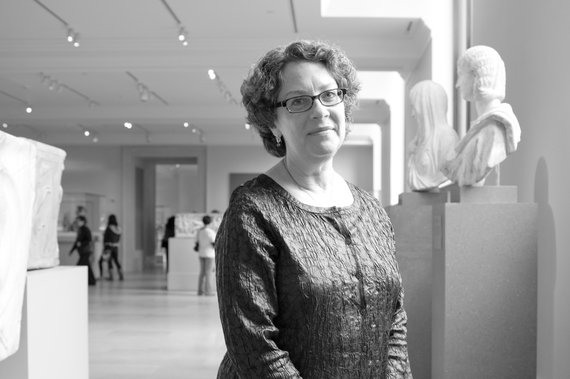A few semesters ago, a group on my job organized a guided tour of an exhibition at the Metropolitan Museum of Art, which was then generating a lot of interest, "Interwoven Globe: The Worldwide Textile Trade, 1500-1800." That exhibition was coordinated and curated by the Marica F. Vilcek curator of American Decorative Arts at the Met, Amelia Peck. As I walked around in those dazzling rooms at the Metropolitan Museum, I remember wondering about the woman who could pull together an exhibition that was truly global in scope. An exhibition that traced routes and roots from the Near and Far East, Europe, Africa and the Americas. Without knowing it, I was subconsciously trying to make connections between Amelia Peck and the work that she had done.
Amelia Peck is a rare breed: she is a New Yorker through and through. Born in New York City, Peck spent her first two years in Forest Hills, Queens, before ending up in Hastings-on-Hudson, just 20 miles outside of the city, where she lives today. In high school she sculpted and sewed -- activities that she still does -- before she focused on theater design. "Because of my love of sewing, I thought I would end up a theater designer," she told me. "When I went off to Brown University I was an English major, since the theater department was part of the English department at that time. I enjoyed being an English major, though, because I've always been a great reader of novels. I guess, looking on some might think it unusual for an English/theater arts major to grow up to be a curator, but there are great similarities between the two fields. As a curator I find that I am always writing to, and communicating with, the public. And what is an exhibition if it is not gathering together objects to tell a fascinating story, exactly as is done in the theater?"
While at Brown, Peck discovered the fields of architectural history and material culture -- which Peck defines as the study of everyday objects that people use -- and after a couple years of designing costumes for theater productions, Peck switched her focus and went to Columbia University to get a degree in historic preservation. In 1981 she came to the Metropolitan Museum as a summer intern, and except for a year away, she has pretty much found her place and her calling there. "What is so fascinating about looking at objects through the lens of material culture," Peck told me, "is that you can interpret how people lived through the objects that they either had or created. As a curator of decorative arts, I strive to use objects as evidence to highlight the stories of the objects and the people who had or made them. This is particularly important if you begin considering the implications for telling women's stories. These objects can be the voice and give voice to the subsumed and voiceless in a way that is unparalleled. The only way oftentimes to tell a woman's story is through the objects that she made. These objects help us to understand this person's life and the period they lived through.
"I recently acquired for the museum a lovely embroidered seat cover that has been passed down in one family through seven generations for the last three hundred years. I have been able to trace this seat down through every generation of women in that family. Thankfully, someone had the good sense to record the name of the woman who initially made the seat cover. Think about it: Someone had to say to themselves, my mother made this and it is important. This is what is left of the things that my mother made. This is worth holding onto, as a record of my mother's life."
At The Metropolitan Museum of Art, Peck has three areas that she is in charge of: She is the American textile curator and oversees all textiles from the earliest period of American history to the first half of the twentieth century. She makes sure that the textiles are cared for, acquires relevant pieces for the Met, and she designs exhibitions around the textiles in the collection. She is also in charge of the Period Rooms at the Museum and is very pleased with introducing interpretative computer screens to the Period Rooms. As well, she is the Manager of the Henry R. Luce Center for the Study of American Art. "I feel very privileged to have a job where I get to work with and think about really fascinating objects. Essentially in my job, I get to learn about objects and use them to tell stories about peoples' lives. I am always learning something new and always telling a different story." She continues, "Another great pleasure of my job is that at the Metropolitan Museum there is this wonderful community of colleagues, who are real experts on their subject matter. The depth of their knowledge is nothing short of breathtaking."
Still, I wanted to know more about the field of material culture and its inclusion in museums. Peck readily admits that there is more acceptance of the traditional field of art history, especially since material culture is a hybrid field that incorporates several disciplines. Furthermore, she concedes that objects like textiles, pottery or furniture are oftentimes thought of as commonplace and not collectable. There is an informality to decorative art objects, she admits, and it is harder for some people to look at everyday objects as "great art." "In the exhibition 'Interwoven Globe,' for example, people would go up and touch the textiles hanging on the walls in ways that they would not dare touch an oil painting. They felt that they could do this with textiles, because textiles are more familiar and are conceived of as everyday and commonplace."
Still, Peck believes that there is growing appreciation for textiles. Particularly so in the United States. "Patchwork quilts, for example, formed from multiple pieces of fabric, are part of how Americans understand and seek to portray themselves as the scrappy pioneers who built this country bit by bit." In the over thirty years that Peck has been in the field, she has noticed that there has been a rise in the appreciation for non-traditional quilts, in large part because modern quilts, such as the quilts of Gee's Bend, raised appreciation of idiosyncratic kinds of quilts. All the more reason, Peck insists, that young women in particular who are artists should not be afraid to utilize textiles in their works.
"I would say to a young woman who wants to work with or design textiles that there are huge possibilities in this medium for you to put your own spin on things and for you to influence the visual culture. Everybody has an association with textiles, for example, and will always have an association with textiles, through clothing and home furnishings, so this is a medium that will always remain relevant."
Similarly, she encourages more young women to enter the field of curating, particularly becoming curators of decorative arts. "As a curator of decorative arts you really get in touch with people from the past and their loves through objects. You get to understand how things are made, and, if you are a history buff like myself, you get the chance, time and time again, to engage with history. Being a curator is truly a wonderful thing. You get to tell stories. And in some cases you get to give a voice to the voiceless. You get to 'un-silence' those who might have been completely forgotten if not for the objects they made with their hands."
Until next time.

